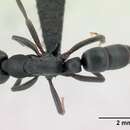en
names in breadcrumbs


Little is known about the biology of L. falcigera. It occurs mainly in low elevation sites on Hawaii (Reimer, 1994), and the average elevation for specimen collections included in Antweb (mostly from Madagascar) is 59 m. Colonies are mostly limited to fewer than 50 workers (Reimer, 1994). Like most of its congeners the queens of L. falcigera are ergatoid and wingless, and males are relatively uncommon. Specimen records from Palau and Madagascar indicate the species nests in rotting logs and cavities both on and above ground, and mostly solitary workers forage on both strata as well. Many collections were made from sifted leaf litter. Kirschenbaum & Grace (2008)report the species fed mainly on live isopods (which is true for many Leptogenys) and also took 25% sucrose solution. Their study demonstrated that L. falcigera is not an aggressive species, and has a strong capacity for surviving encounters with more dominant ants. In Hawaii, the species is thought to exert little impact on native species on account of its small colony sizes and uncommonness in habitats frequented by native invertebrates.
On Juan de Nova island in the Mozambique Canal, a colony was found nesting in a rot pocket. Here is a picture of the nest.
Native range. Afrotropics? Introduced range. Madagascar, Aldabra Is., Sri Lanka, Hawaian Islands (Kaho'olawe, Kauai, Oahu, Molokai and Maui), Kiribati (Teraina), Palau, Cook Is. (Aitutaki).
Diagnosis among workers of introduced and commonly intercepted ants in the United States. Antenna 12-segmented. Eyes medium to large (greater than 5 facets); situated distinctly below midline of head. Frontal lobes present. Clypeus distinctly triangular and projects anteriorly well beyond the base of the mandibles; anterior margin of clypeus not denticulate. Mandibles linear; inserted towards lateral corners of the of the anterior head margin; edentate and lacking apical fork. Hind coxae lacking dorsal spine. Pretarsal claws pectinate. Waist 1-segmented. Petiole upright; conspicuous posterior face; narrowly attached to gaster. Gaster armed with sting. First gastral tergite (abdominal segment 4) lacking deep longitudinal furrows. Distinct constriction between abdominal segments 3+4. Color dull black.
Among introduced and commonly intercepted ants of the United States, L. falcigera is immediately recognizable by the triangular clypeus and long falcate mandibles. The only other ponerine genera in this class that might be confused with Leptogenys are Anochetus and Odontomachus, both of which also have linear mandibles. However, Leptogenyus can be easily distinguished by from these two genera by the mandibles which are inserted laterally (versus medially) into the clypeus, the triangular and anteriorly projecting clypeus, and the pectinate (versus simple) pretarsal claws. Leptogenys maxillosa is a very closely related species that is also a tropical tramp and has been introduced into Cuba and Brazil. Leptogenys falcigera can be separated from L. maxillosa by the petiolar node, which in dorsal view is at least as long as broad and usually distinctly longer than broad (Bolton, 1975).
Leptogenys falcigera is a large (7.0–7.8 mm), dull black ant with large eyes, a projecting triangular clypeus, and long, edentate and falcate mandibles. The combination of the clypeus shape and curved mandibles give the ant a distinctly ‘smiling’ appearance. The native range of L. falcigera is somewhat of a mystery. Although generally considered to be of African origin, the species has not been recorded from the continent. Although common across Madagascar’s coastal habitats and surrounding islands, the species does not penetrate into the interior. Otherwise L. falcigera is only known from Sri Lanka and Pacific islands. Leptogenys falcigera is the type species for the genus, and was first described from Sri Lanka (Roger, 1861). The Hawaiian population was originally described in the late 1879 as a new species under the name L. insularis Smith, F., which was later synonymized with L. falcigera by Wilson & Taylor (1967). The maxillosa group, to which L. falcigera belongs, includes several other species which are also tropical tramps and likely rely on human commerce for transportation (Bolton, 1975). Although the species is associated with disturbed habitats, it is not considered a significant pest (Reimer, 1994).
Taxonomic history
Forel, 1891c PDF: 111 (m.).Senior synonym of Leptogenys insularis: Wilson & Taylor, 1967b PDF: 30.Status as species: Bolton, 1975a PDF: 252; Xu & He, 2015 PDF: 150 (in key).
Leptogenys falcigera, is a species of ant of the subfamily Ponerinae.[1]
Comoros, Guam, Hawaii, Marshall Islands, Micronesia, Palau, Philippines, Madagascar, Mauritius, Sri Lanka.